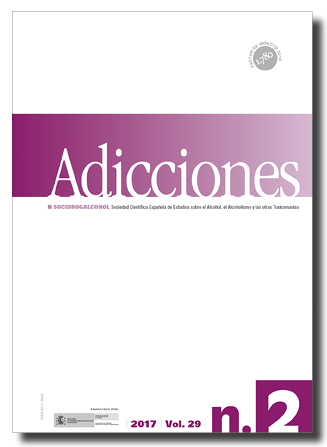Perspectivas en el tratamiento del síndrome de hiperemesis por cannabis
DOI:
https://doi.org/10.20882/adicciones.875Palabras clave:
cannabis, hiperemesis, capsaicina, haloperidolResumen
Presentamos casos sobre posibles tratamientos efectivos para tratar los síntomas del Sindrome de Hiperemsis por cannabis: el haloperidol y la pomada de capsaicina.Citas
Aguilar-Salmerón, R., Martínez-Sánchez, L., Broto-Sumalla, A., Fernández de Gamarra-Martínez, E., García-Peláez, M. y Nogué-Xarau, S. (2016). Recomendaciones de disponibilidad y utilización de antídotos en los hospitales según su nivel de complejidad asistencial. Emergencias, 28, 45-54.
Allen, J.H., de Moore, G.M., Heddle, R. y Twartz, J.C. (2004). Cannabinoid hyperemesis: cyclical hyperemesis in association with chronic cannabis abuse. Gut, 53, 1566-1570. doi:10.1136/gut.2003.036350.
Biary, R., Oh, A., Lapoint, J., Nelson, L.S., Hoffman, R.S. y Howland, M.A. (2014). Topical capsaicin cream used as a therapy for cannabinoid hyperemesis syndrome. 2014 Annual Meeting of the North American Congress of Clinical Toxicology (NACCT). Clinical Toxicology. 52, 787.
Bruguera P., López-Pelayo H., Miquel L y Balcells-Oliveró M. (2016). Elevada prevalencia del síndrome de hiperémesis cannábica en pacientes consumidores de cánnabis. Emergencias, 28, 249-251.
Carnevale, V. y Rohacs, T. (2016). TRPV1: A Target for Rational Drug Design. Pharmaceuticals, 9, 52. doi:10.3390/ph9030052
Contreras Narváez, C., Mola Gilbert, M., Batlle de Santiago, E., Bigas Farreres, J., Giné Serven, E. y Cañete Crespillo, J. (2016). Cannabinoid hyperemesis syndrome. A report of six new cases and a summary of previous reports. Adicciones, 28, 90-98. doi:10.20882/adicciones.776
Hickey, J.L., Witsil, J.C. y Mycyk, M.B. (2013). Haloperidol for treatment of cannabinoid hyperemesis syndrome, The American Journal of Emergency Medicine, 31, 1003.e5–1003e6. doi:10.1016/j.ajem.2013.02.021.
Jones, J.L. y Abernathy, K.E. (2016). Successful Treatment of Suspected Cannabinoid Hyperemesis Syndrome Using Haloperidol in the Outpatient Setting. Case Report in Psychiatry, 2016, 3614053. doi:10.1155/2016/3614053
Kim, H.S. y Monte A.A. (2016). Colorado Cannabis Legalization and Its Effect on Emergency Care. Annals of Emergency Medicine, 68, 71–75. doi:10.1016/j.annemergmed.2016.01.004
Lapoint J. (2014a). Case series of patients treated for cannabinoid hyperemesis syndrome with capsaicin cream. 2014 Annual Meeting of the North American Congress of Clinical Toxicology (NACCT). Clinical Toxicology. 52, 707.
Lapoint, J. (2014b). Capsaicin cream for treatment of cannabis hyperemesis syndrome. The Journal of Medical Toxicology, 10, 77.
Pélissier, F., Claudet, I., Gandia-Mailly, P., Benyamina, A. y Franchitto, N. (2016). Cannabis Hyperemesis Syndrome in the Emergency Department: How Can a Specialized Addiction Team Be Useful? A Pilot Study. The Journal of Emergency Medicine, S0736-4679(16)30267-0. Avance de publicación on-line. doi:10.1016/j.jemermed.2016.06.009.
Román, F., Llorens, P. y Burillo-Putze, G. (en prensa). Topical capsaicin cream in the treatment for cannabinoid hyperemesis syndrome. Medicina Clínica (Barcelona).
Yi, C.H., Lei, W.Y., Hung, J.S., Liu, T.T., Orr, W.C.,.… Chen, C.L. (2016). Differences in the Control of Secondary Peristalsis in the Human Esophagus: Influence of the 5-HT4 Receptor versus the TRPV1 Receptor. PLoS ONE, 11, e0159452. doi:10.1371/journal.pone.0159452.








